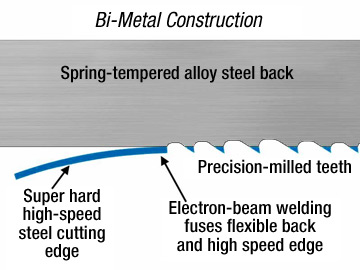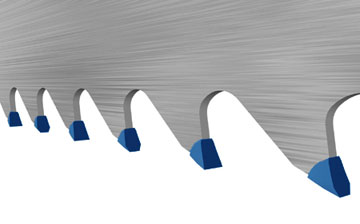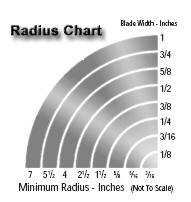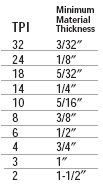Craftsman 4 1/2 Inch Horizontal Metal Cutting Band Saw Reviews
89-ane/2" Bandsaw Blades
89-1/ii" Ring saw Blades to fit
12" Craftsman 922400
- Construction
- Cloth Type
- Product Tag
- Terms
- Tooth Form
- Width, Thickness, TPI
Blade Construction
Blades tin can be made from one piece of steel, or built upwards of two pieces, depending on the performance and life expectancy required.Carbon Blades
Hard Dorsum type:
A ane-piece blade made of carbon steel with a hardened dorsum and tooth edge.
Flex Back type:
A jumpsuit blade made of carbon steel with a hardened tooth border and soft back.
Bi-metal Blades
A high speed steel border material is electron axle welded to fatigue resistant bound steel backing. Such a structure provides the all-time combination of cutting performance and fatigue life.

Carbide Footing Tooth Blades
Teeth are formed in a high strength leap steel alloy backing material.
Carbide is bonded to the tooth using a proprietary welding operation. Tips are and then side, face and superlative footing to form the shape of the tooth.

Set Style Carbide Tooth
Teeth are placed in a high strength leap blend backing material. Carbide is bonded to the tooth and ground to class the shape of the tooth. The teeth are and so set, providing for side clearance.
BANDSAW Bract MATERIAL TYPES
Cutting Wood using a Wood Bandsaw:
- Flex-Back -Carbon Steel Blade - General Wood cutting operations
- Neo-Type - Carbon Steel Blade (Hardback) tooth size viii to 24 tpi for sparse wood and plastics (originally for cutting metal just at 75 to 300 BFPM)
- #32 Wood -Specialized Woodworking Applications
- Diemaster 2 - Bi-Metallic bract, provides 6x the life of Carbon Steel bract stock
- Archetype - Bi-Metal blade, provides 6x the life of Carbon Steel bract stock
- Woodmaster B - Bi-Metallic blade specifically for utilize on Portable Band Mills also Horizontal and Vertical Re-Saws
- Woodmaster CT - Carbide Tipped for utilize on Portable Ring Mills too Horizontal and Vertical Re-Saws
- Tri-Primary - Carbide Tipped Precision triple chip grind results in smooth cuts and excellent finish.
Cutting Metallic on a Wood Bandsaw:
- Diemaster ii - Bi-Metal blade, provides 6x the life of Carbon Steel bract stock
- Matrix - Bi-Metallic bract, .020 thick, provides 6x the life of Carbon Steel bract stock
- Archetype - Bi-Metal bract, provides 6x the life of Carbon Steel blade stock
- Archetype Pro - Bi-Metal blade, provides 6x the life of Carbon Steel blade stock
Annotation:
When using a Wood Cutting band saw for cut metallic (saw running about 3000 BFPM) hardened metallic volition not be able to exist cut. Bandsaw bract speeds betwixt 75 and 300 BFPM are required to cut hardened materials and receive favorable bract life. If your wood saw has two speeds, use the slow speed for cut soft metal.
Selecting the Proper TPI (teeth per inch):
When cutting woods, the Rule of Thumb is three to 12 teeth in the piece of work, with the most full general purpose count being half dozen TPI. The fewer teeth per inch provide a faster, but rougher cut; and more teeth per inch provide a smoother, only slower cut. When resawing use the widest blade suitable for your saw with the fewest number of teeth per inch. Make sure that you lot select a bract of proper thickness. The continual flexing of the blade causes metal fatigue and failure of the blade. Fatigue is the tendency of a metallic to break under connected flexing. The thickness of the blade required depends upon the diameter of the wheels and the piece of work to be washed. Thick blades volition withstand more strain from cutting than thin blades, merely volition break more easily from the bending activity, especially when run on small wheels. Each revolution flexes the blade to well-nigh the elastic limit of the steel, which causes the metal to fatigue and intermission rapidly. Thinner blades are recommended when the piece of work is light.
*Bandsaw Blade Speed BFPM is Band Feet Per Minute
The types of Lenox Ring Saw Blade stock listed below
are for general metal cutting to high performance metal cutting operations
Bi-Metal Bract Product Pick Chart
Bi-Metallic Speed Selection Chart
Bi-Metallic Tooth Selection Chart
LENOX Bi-Metal Band Saw Blades
Loftier speed steel tooth tips combined with flexible blend steel backing material results in band saw blades that are the most price effective choice for most metal sawing applications. A wide variety of products are available to ensure optimal blade functioning in your application.- Diemaster 2 - Bi-Metal bract, provides 6x the life of Carbon Steel blade stock
- Matrix - Bi-Metal blade, .020 thick, provides 6x the life of Carbon Steel blade stock
- Classic - The Ultimate Multi-Purpose
- Classic Pro -The Ultimate Multi-Purpose Blade for Product Cutting
- QXP - Long Blade Life at Loftier Cutting Rates
- RX+ - Engineered to Cut Structurals, Tubing and Bundles
- Armor RX+ - Engineered for Long Life
- Contestor GT - Loftier Operation Sawing
Carbide Speed Selection Chart
Carbide Tooth Selection Chart
LENOX Carbide Band Saw Blades
High operation backing steel and optimized carbide grades give premium band sawing operation. These band saws will cut faster and last longer than whatsoever other ring saw blade in a broad variety of sawing applications.
- ARMOR CT BLACK -For Extreme Cutting Rates
- TNT GT - Farthermost Performance on Super Alloys
- CAST Chief -Superior Performance When Sawing Castings
- TRI-TECH CT -Set Style Carbide Blade for Difficult to Cut Metals
- TRI-MASTER -Versatile Carbide Tipped Blade
- ALUMINUM MASTER CT -Triple Chip Tooth Pattern
- HRc -Carbide Tipped Blade for Instance and Through-Hardened Materials
- Principal GRIT -Carbide Grit Edge Blade for Cut Abrasive and Hardened Materials
A clear understanding of blade terminology can help avert defoliation when discussing cutting problems. BAND SPEED BASE Ring SPEED BI-Metal BLADE WIDTH CARBIDE TIPPED BLADE CARBON FLEX Back CARBON Difficult BACK Cutting Charge per unit DEPTH OF PENETRATION Equally with a bi-metal blade design, there are advantages to differing tooth constructions. The carbide tipped tooth has carbide tips welded to a high forcefulness alloy back. This results in a longer lasting, smoother cutting blade. The shape of the molar's cutting border affects how efficiently the bract tin cut through a piece of cloth while considering such factors as blade life, noise level, smoothness of cut and chip carrying chapters. Variable Positive - Variable tooth spacing and gullet capacity of this design reduces noise and vibration, while allowing faster cut rates, long bract life and smooth cuts. Variable - A design with benefits similar to the variable positive form for use at slower cut rates. Standard - A good full general purpose blade blueprint for a wide range of applications. Skip - The wide gullet pattern makes this blade suited for non-metal applications such every bit forest, cork, plastics and limerick materials. Hook - Similar in design to the Skip form, this high raker blade can be used for materials which produce a discontinuous chip (such as bandage iron), as well as for non-metallic materials. The number of teeth and the angle at which they are offset is referred to every bit "tooth set." Tooth set affects cutting efficiency and chip carrying ability. Raker: Modified Raker: Vari-Raker: Alternate: Wavy: Vari-Fix: Single Level Set: Dual Level Fix: Blade width is measured from the tips to the teeth to the back border of the blade torso. Cutting-Off Sawing (Re-sawing) Contour Sawing How to Choose the Correct Number of Teeth Per Inch (TPI) The number of teeth per inch (TPI) is important in obtaining the stop desired and the proper feed rate. A coarse molar blade (2, 3 TPI) should exist used for re-sawing wood and cutting thicker stock up to 8" thick. A fine toothed blade (18 to 32 TPI) should be used for thinner metals and plastics nether 1/4". For full general cutting of 3/iv" plywood 6 TPI will provide a fast cut and 14 TPI will cut much slower just exit a polish stop on the cutting. When Selecting TPI Call back: Band Saw Blade Thickness The thickness of a bandsaw blade is determined past the thickness of the blade body. Bandsaw blades vary in thickness .014", .018", .020", .022", .025", .032", .035", .042", .050", .063". This chart offers Guidelines for selecting Bract Thickness for bike diameters. It is non e'er possible to adhere to the above recommendations due to the cutting operation you lot intend to perform and the particular band saw you are using. To maintain extended fatigue life of the blade, select the thinnest blade possible that will offer you the advisable number to TPI to perform you cut functioning.Understanding Product Tag

H A = Claw Tooth, Alternate Set up
H L = Claw Tooth, Lenox Set
H R = Hook Tooth, Raker Set
Due south L = Standard Tooth, Lenox Set
S R = Standard Molar, Raker Set
Due south W = Standard Tooth, Wavy Set
5 W = Vari-Tooth, Wavy Set up
V P = Vari-Molar, Positive
VP TR = Vari-Position, Triple Scrap
STP R = Triple Scrap
STP TR = Triple Chip
VP TR = Varied Position, Triple Scrap
VP TR 051 = Varied Position, Triple Fleck .051 kerf
VP TR 065 = Varied Position, Triple Flake .065 kerf
VP TR 072 = Varied Position, Triple Chip .072 kerf
VP TR 085 = Varied Position, Triple Scrap .085 kerf
VP VR = Varied Position, Varied Raker
VP VR EHS = Varied Position, Varied Raker, Extra Heavy Set Bandsaw Blade Terms

i. Blade Back - The body of the bract not including tooth portion.
2. Gauge - The thickness of the blade.
3. Width - The nominal dimension of a saw blade every bit measured from the tip of the tooth to the back of the band.
4. Set - The angle of teeth to right or left to allow clearance of the back of the blade through the cut.
5. Tooth - The cutting portion of a saw blade.
half dozen. Tooth Pitch - The distance from the tip of one tooth to the tip of the side by side tooth.
seven. TPI - The number of teeth per inch equally measured from gullet to gullet.
viii. Gullet - The curved area at the base of the tooth. The tooth tip to the bottom of the gullet is the gullet depth.
nine. Gullet Depth - The distance from the tooth tip to the bottom of the gullet.
10. Tooth Face - The surface of the tooth on which the fleck is formed.
xi. Tooth Back - The surface of the tooth opposite the tooth face.
12. Molar Back Clearance Angle - The angle of the molar dorsum measured in relation to the cutting management of the saw.
xiii. Tooth Rake Angle - The angle of the tooth face measured with respect to a line perpendicular to the cut management of the saw.
14. Tooth Tip - The cutting edge of the saw molar.
15. Kerf - Amount of material removed by the cut of the blade.
The rate at which the band saw bract moves beyond the work to be cut. The charge per unit is commonly measured in feet per minute (fpm) or meters per minute (mpm).
Listing of recommended speeds for cutting various metals, based on a iv" wide piece of that stock.
A high speed steel edge material electron beam welded to a spring steel dorsum. Such a structure provides the best combination of cutting performance and fatigue life.
The dimension of the band saw bract from tooth tip to blade dorsum.
Carbide tips welded to a high-strength alloy back, resulting in a longer lasting, smoother cutting blade.
A solid jumpsuit bract of carbon steel with a soft back and a hardened molar, providing longer bract life and generally lower price per cutting.
A one-piece blade of carbon steel with a hardened dorsum and molar edge that can have heavier feed pressures, resulting in faster cutting rates and longer life.
The amount of cloth being removed over a period of time. Measured in square inches per infinitesimal.
The altitude into the cloth the tooth tip penetrates for each cut.Tooth Grade and Structure
Tooth Grade





Tooth Ready

3 tooth sequence with a uniform set angle (Left, Correct, Straight).
v or 7 molar sequence with a uniform set angle for greater cutting efficiency and smoother surface finish (Left, Right, Left, Right, Straight). The gild of gear up teeth can vary by production.
The tooth sequence is dependent on the tooth pitch and product family. Typically Vari-Raker set provides tranquillity, efficient cutting and a smooth finish with less burr.
Every tooth is set in an alternating sequence. Used for quick removal of material when finish is non critical.
Groups of teeth set to each side within the overall set pattern. The teeth have varying amounts of ready in a controlled design. Wavy set is typically used with fine pitch products to reduce noise, vibration and burr when cutting thin, interrupted applications.
The molar summit / set pattern varies with product family unit and pitch. The teeth have varying set magnitudes and set angles, providing for quieter operation with reduced vibration. Vari-Set is efficient for difficult-tocut materials and larger cantankerous sections.
The blade geometry has a single molar height dimension. Setting this geometry requires bending each molar at the same position with the same corporeality of bend on each tooth.
This bract geometry has variable tooth height dimensions. Setting this production requires bending each tooth to variable heights and set magnitudes in order to reach multiple cutting planes.Selecting Bandsaw Blade Width, Thickness and TPI
The instructions for the particular bandsaw beingness used should be followed when selecting bract width.
If no such instructions be, the blade width should exist adamant with the following guidelines:
The blade selected should be every bit broad as the machine will permit, keeping in heed the bract thickness and wheel diameter.
The wider the bandsaw blade is, the straighter the cut volition exist. 
The bandsaw blade should exist as wide equally the machine allows,
but notwithstanding narrow plenty then that it tin cut the desired shape (radius).
Minimum dimensions for dissimilar cutting radii are shown in the radius nautical chart

Make sure that you select a blade of proper thickness. The continual flexing of the bract causes metal fatigue and failure of the bract. Fatigue is the tendency of a metal to break nether continued flexing.
The thickness of the blade required depends upon the diameter of the wheels and the work to be washed. Thick blades will withstand more than strain from cutting than thin blades, but will brake more easily from the bending activeness, especially when run on small wheels. Each revolution flexes the bract to nearly the elastic limit of the steel, which causes the metal to fatigue and brake rapidly. Thinner blades are recommended when the work is light.
WHEEL Bore
RECOMMENDED
BLADE THICKNESS 4-6 inches
vi-8 inches
8-11 inches
11-xviii inches
xviii-24 inches
24-xxx inches
30 inches
and over .014"
.018"
.020"
.025"
.032"
.035"
.042", .050", .063" .014", .018" .020" thicknesses are no longer available in Lenox brand
Source: https://www.toolcenter.com/089_5_Band_saw_Blades.html